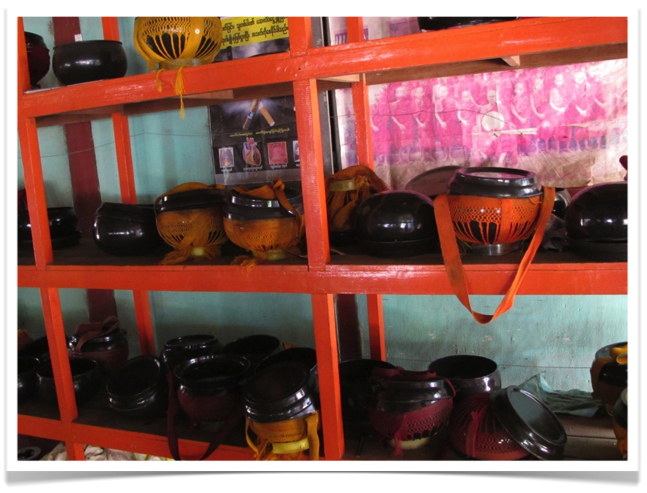Entries from July 1, 2014 - July 31, 2014
A Threat to Cambodia's Sacred Forests
 Wednesday, July 30, 2014 at 9:29AM
Wednesday, July 30, 2014 at 9:29AM Beautiful documentary by Kaylanee Mam about the threat to forests and forest dwellers caused by the planned construction of a hydroelectric dam in the pristine Areng Valley of southwest Cambodia. Just one of the innumerable violations of nature and indigneous humanity that occurs, it seems, almost every day on this planet. I post this piece because the Chong village is very close to where we did some of our rattan work in Cambodia (see Finally, Its a Book). [NOTE: Go here and here to find out more about the proposed dam and what you can do about it].
Tripitaka
 Tuesday, July 29, 2014 at 10:11AM
Tuesday, July 29, 2014 at 10:11AM 
I noticed that the gates on some of the shrines at Kuthodaw (See Kuthodaw) were open and that rugs were laid out on the floor. Apparently, you can climb inside and sit with the stone tablet of a Tripitaka page and reflect on its meaning. [NOTE: This is probably a more common practice during the rainy season when the temperatures in Mandalay drop a bit. Was oppresively hot the day I visited, and I bet it was like an oven inside these shrines].
Kite Fight
 Monday, July 28, 2014 at 11:09AM
Monday, July 28, 2014 at 11:09AM Beautiful video about flying kites in the crowded favelas of Rio de Janeiro. Kids coat the kite strings with powered glass and duel with the other kites. Saw the same sort of competitive kite flying in Pontianak, West Kalimantan when I lived there in the 1990's. You'd pick up a wad of string on the street to throw it away and cut your fingers. Ouch. [NOTE: Filmmaker Guilherme Tensol produced the documentary for the New York Times].
Field Shoes
 Friday, July 25, 2014 at 11:03AM
Friday, July 25, 2014 at 11:03AM 
Most of the time villagers don't have the right footwear for running transects through spiny rattan thickets. Flip-flops are usually the only shoe option. To get around this, we usually bring a large assortment of Chinese canvas field boots for people to use. Real cheap, they offer some traction, and they will keep a spine from going into your foot. As is shown above, trying on the field shoes is a much anticipated activity. [NOTE: You get to keep the boots after the fieldwork is finished].
[NOTE: I just added a new header. Shows me (a bit blurry) taking a photo of the skeleton of a ring-tailed lemur (Lemur catta) at the California Academy of Sciences].
 Field Shoes,
Field Shoes,  Myanmar,
Myanmar,  Nam Sabi in
Nam Sabi in  Other,
Other,  Science |
Science |  Share Article |
Share Article |  Email Article |
Email Article |  Print Article
Print Article Thoughts on Science and Nature
 Thursday, July 24, 2014 at 9:55AM
Thursday, July 24, 2014 at 9:55AM 
This from C.S. Lewis in English Literature in the Sixteenth Century, Oxford, 1954, pp.3-4:
What was fruitful in the thought of the new scientists was the bold use of mathematics in the construction of hypotheses, tested not by observation simply but by controlled observation of phenomena that could be precisely measured. On the practical side, it was this that delivered Nature into our hands (emphasis mine). By reducing Nature to her mathematical elements it substituted a mechanical for a genial or animistic conception of the universe. The world was emptied, first of her indwelling spirits, then of her occult sympathies and antipathies, finally of her colors, smells, and tastes.
Man with his new powers became rich like Midas but all that he touched had gone dead and cold. This process, slowly working, ensured during the next century the loss of the old mythical imagination: the conceit, and later the personified abstraction, takes its place.
This passage rewards re-reading slowly. In spite of what I do for a living (see What I Do), there is much, very much, that I agree with here.
Alms Bowls
 Wednesday, July 23, 2014 at 10:08AM
Wednesday, July 23, 2014 at 10:08AM 
Alms bowls lined up in the Homalin monastery (see Roadwork). A key piece of equipment in many Theravadan countries, the bowls are used to collect food during the morning alms rounds. It is important to note that this is not "begging". There is, ideally, a reciprocal sharing of merit that occurs when a householder drops food into a monk's bowl. And there is "no gift", "no giver", and "no receiver". Giving purely in this way, without attachment or expectations, is called dana paramita in Sanskrit.
Distant Neighbors
 Tuesday, July 22, 2014 at 10:13AM
Tuesday, July 22, 2014 at 10:13AM 
About halfway through the new book Distant Neighbors, which presents a fascinating collections of letters between two of my heros, Gary Snyder (see Gary Snyder at 83) and Wendell Berry. What a lively and thoughtful dialogue - and a lovely friendship. They exchanged nearly 250 letters from 1973 to 2013. A snippet from Snyder's letter to Berry on June 3, 1977:
"The question I ask myself is, what next? My ignorance of the dynamics of economics troubles my sleep. I must keep working on that. Because, (as my study of China is showing more and more) the best intentions in the world will not stop the inertia of a heavy civilization that is rolling on its way. As poets, our politics mostly stand back from that flow of topical events; and the place we do our real work is in the unconscious, or myth-consciousness of the culture; a place where people decide (without knowing it) to change their values."
[NOTE: There is a powerful and subtle logic on display in these letters. I highly recommed this book].
Dragonfly
 Monday, July 21, 2014 at 10:39AM
Monday, July 21, 2014 at 10:39AM 
Apropos of nothing, except perhaps to add a timeframe to your Monday, shown above is a fossil of Stenophlebia latrelli, an extinct genus of dragonfly from the late Jurrasic. i.e. about 150 million years ago. Deep time. Collected from the Solnhofen quarry in Eichstatt, Germany. [NOTE: Photographed in the California Aacademy of Sciences].
 Jurassic,
Jurassic,  Stenophlebia latrelli,
Stenophlebia latrelli,  dragonfly in
dragonfly in  Science |
Science |  Share Article |
Share Article |  Email Article |
Email Article |  Print Article
Print Article Echinopsis (and pollinator)
 Friday, July 18, 2014 at 9:41AM
Friday, July 18, 2014 at 9:41AM 
Echinopsis sp. cactus in flower at the UC Berkeley Botanical Garden. [NOTE: Probably Echinopsis chiloensis (Colla)Friedrich & G.D. Rowley (Catalog No. 52.0568)].
And a close-up of some pollination activity:




